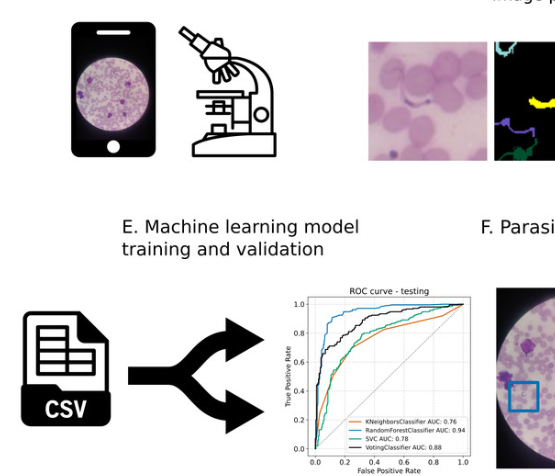Automatic detection of the parasite Trypanosoma cruzi in blood smears using a machine learning approach applied to mobile phone images
Chagas disease is a life-threatening illness caused by the parasite Trypanosoma cruzi. The diagnosis of the acute form of the disease is performed by trained microscopists who detect parasites in blood smear samples. Since this method requires a dedicated high-resolution camera system attached to the microscope, the diagnostic method is more expensive and often prohibitive for low-income settings. Here, we present a machine learning approach based on a random forest (RF) algorithm for the detection and counting of T. cruzi trypomastigotes in mobile phone images. We analyzed micrographs of blood smear samples that were acquired using a mobile device camera capable of capturing images in a resolution of 12 megapixels. We extracted a set of features that describe morphometric parameters (geometry and curvature), as well as color, and texture measurements of 1,314 parasites. The features were divided into train and test sets (4:1) and classified using the RF algorithm. The values of precision, sensitivity, and area under the receiver operating characteristic (ROC) curve of the proposed method were 87.6%, 90.5%, and 0.942, respectively. Automating image analysis acquired with a mobile device is a viable alternative for reducing costs and gaining efficiency in the use of the optical microscope.
Authors
Morais, Mauro Cesar Cafundo; Silva, Diogo; Milagre, Matheus Marques; de Oliveira, Maykon Tavares; Pereira, Thais; Silva, Joi£o Santana; Costa, Luciano da F; Minoprio, Paola; Junior, Roberto Marcondes Cesar; Gazzinelli, Ricardo;
External link
Publication Year
Publication Journal
Associeted Project
User-friendly computational Tools
Lista de serviços
-
As antisense RNA gets intronic.As antisense RNA gets intronic.
-
Androgen responsive intronic non-coding RNAs.Androgen responsive intronic non-coding RNAs.
-
Conserved tissue expression signatures of intronic noncoding RNAs transcribed from human and mouse loci.Conserved tissue expression signatures of intronic noncoding RNAs transcribed from human and mouse loci.
-
The intronic long noncoding RNA ANRASSF1 recruits PRC2 to the RASSF1A promoter, reducing the expression of RASSF1A and increasing cell proliferation.The intronic long noncoding RNA ANRASSF1 recruits PRC2 to the RASSF1A promoter, reducing the expression of RASSF1A and increasing cell proliferation.
-
Antisense intronic non-coding RNA levels correlate to the degree of tumor differentiation in prostate cancer.Antisense intronic non-coding RNA levels correlate to the degree of tumor differentiation in prostate cancer.
-
Insight Into the Long Noncoding RNA and mRNA Coexpression Profile in the Human Blood Transcriptome Upon Leishmania infantum Infection.Insight Into the Long Noncoding RNA and mRNA Coexpression Profile in the Human Blood Transcriptome Upon Leishmania infantum Infection.
-
Long non-coding RNAs associated with infection and vaccine-induced immunityLong non-coding RNAs associated with infection and vaccine-induced immunity
-
Comparative transcriptomic analysis of long noncoding RNAs in Leishmania-infected human macrophagesComparative transcriptomic analysis of long noncoding RNAs in Leishmania-infected human macrophages
-
SARS-CoV-2 Selectively Induces the Expression of Unproductive Splicing Isoforms of Interferon, Class I MHC, and Splicing Machinery Genes.SARS-CoV-2 Selectively Induces the Expression of Unproductive Splicing Isoforms of Interferon, Class I MHC, and Splicing Machinery Genes.

